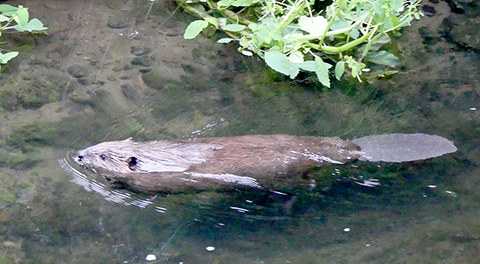Go Beavs!

By Dean Moberg, Director, and Charlotte Trowbridge, Conservation Education Coordinator, Tualatin Soil and Water Conservation District
This article pertains not to OSU sports teams, but instead to North America’s largest rodent, a common resident of Cedar Mill and Oregon’s state animal. The American beaver (Castor canadensis) was trapped almost to extinction across America by the 1800s, due largely to demand for beaver pelts. The undercoat of beaver fur is dense, and each hair is covered with tiny barbs that lock together – qualities that allow production of durable felt that can be formed into hats. Those top hats gentlemen doffed back in the day were made from beaver felt. However, after silk hats became fashionable in the 1840s, decreasing demand for beaver fur allowed these unique animals to make a remarkable come-back.

Adult beavers average 40 pounds in weight and 40 inches in length, including that distinctive flat tail. They have webbed hind feet, valves that close their nose and ears when underwater, and an oil gland that waterproofs their fur. When threatened, beavers slap their tail in the water and then submerge for up to 15 minutes before needing to breathe.

Beavers usually mate for life (5-10 years) and have one litter of kits each spring. They are nocturnal, venturing out after dark to snip off branches or to topple large trees, which they use for food and to build their signature dams. They often build lodges out of wood and mud, but will also build dens by burrowing into streambanks. You can see a beaver lodge, downed trees, and dams in the restored wetland just east of Saltzman and north of Burton. That lodge is large enough to see in the satellite view of Google Maps.
Beavers provide a variety of ecological benefits. Their ponds provide habitat for fish, amphibians, waterfowl, and songbirds. Beaver dams regulate water flow, decreasing downstream flooding in the winter and helping maintain higher streamflow in the summer. The ponds also improve water quality by trapping sediment. Beaver damage to trees may look intense, but many species they favor, like willows, are well-adapted to beavers and readily sprout back with multiple branches.
Despite the many ecological benefits that beavers provide, they can sometimes damage backyard trees or flood homes. The Oregon Department of Fish and Wildlife provides a concise review of beaver biology, which offers suggestions on legal and ecological ways to reduce beaver damage.
Two other aquatic rodents live in Cedar Mill. Muskrats are small (kitten-size) aquatic rodents with a tail visible while swimming. Nutria are larger (size of a schnauzer) with a rat-like tail visible while swimming. You can often see nutria in the wetlands that straddle Barnes Road, south of Market of Choice.
A large aquatic rodent with a broad flat tail that stays underwater while swimming is the American beaver. However, it’s more likely you will see their dams and gnawed trees than the beavers themselves during daylight. Beavers are remarkable, unique creatures that improve habitat, restore natural stream flow, and help to bring nature into Cedar Mill.
Perhaps in a future article, we can discuss the water fowl that make use of beaver ponds. Go Ducks!
In response to a reader question, Dean sent this additional information!
Regarding how many live in that colony:
- Usually, there is just one pair of mated adults (they start to breed around age three). (2)
- Their young from last year should still be with them and they usually have a litter of three to five. (4)
- They will have a new litter in May. (4)
So, adding the number in parentheses: there should be around six there now, with four more on their way in May. That’s assuming none have been killed by dogs, coyotes, or cars.
Probably later this year the young from last year will strike off to look for their own habitat. Sometimes, the young will stay with the clan for an additional year. The colonies are generally a family unit. Beavers live for 10-15 years and are considered monogamous.
Their lodge and the dams off of Saltzman were no doubt built over many years and the beavers have surely added to their work over time. The dams sometimes break or leak and then the beavers go into action to repair the breach. They key in on the sound of running water, which alerts them to the broken part of the dam.
People have used that habit to reduce flooding from dams. For example, let’s say a beaver dam is causing too much water to be backed up (maybe threatening a building or some cropland). The landowner might like the beavers in general, but just wants to reduce the amount of water they are backing up. In that case, the owner can cut a slot through the dam and install a plastic culvert in the bottom of the slot. The beavers will quickly rebuild the dam, covering up the pipe. If both ends of the pipe stay underwater, there will be no sound of running water and the beavers won’t try to clog up the pipe. By sizing the pipe just right, you can keep the pond big enough for the beavers but not so big that it hurts the landowner.




